

 |
 |
Homicides of Prisoners of War in Iraq and Afghanistan |

Citation:
Miles SH; Medical investigations of homicides of prisoners of war in Iraq and Afghanistan.
Medscape General Medicine July 5, 2005;7(3)
http://www.medscape.com/viewarticle/507284_1
CHAS NOTE:
Thank you, Joe of Pennsylvania for sending me ("US") this article!
If you want to view this article (over 14 web pages) on Medscape, CLICK HERE
[I don't know how long Medscape articles are maintained on the Internet.
So, I've posted it HERE – following the author's textbook link.]

June 27, 2006:
The author of this article asked that I post a link to his new book about this subject.
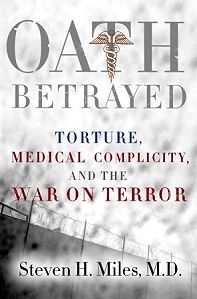 |
 |
Torture, Medical Complicity, and the War on Terror Written by Steven Miles |
From the Random House page:
http://www.randomhouse.com/randomhouse/catalog/display.pperl?isbn=9781400065783
When Steven H. Miles, an expert in medical ethics and an advocate for
human rights, learned of the neglect, mistreatment, and torture of prisoners
at Abu Ghraib, Guantánamo Bay, and elsewhere, one of his first thoughts was:
"Where were the prison doctors while the abuses were taking place?"In Oath Betrayed, Miles explains the answer to this question. Not only were
doctors, nurses, and medics silent while prisoners were abused; physicians and
psychologists provided information that helped determine how much and
what kind of mistreatment could be delivered to detainees during interrogation.
Additionally, these harsh examinations were monitored by health professionals
operating under the purview of the U.S. military.

From Medscape General MedicineTM
Original Article
Medical Investigations of Homicides of
Prisoners of War in Iraq and Afghanistan
Posted [on Medscape] 07/05/2005
AUTHOR:
Steven H. Miles, MD; Professor of Medicine and Bioethics, Center for Bioethics,
University of Minnesota, Minneapolis. Email: miles001@umn.edu

Introduction
The publication of the photographs of the abuse of prisoners at Abu Ghraib has resulted in a widening circle of disclosures and official investigations of similar abuses in Iraq, Afghanistan, and at Guantanamo Bay. There are reports that some medical personnel neglected detainees' medical needs and collaborated with coercive interrogations.[1,2] Some physicians, medics, nurses, and physician assistants failed to report abuses or injuries caused by the abuses that they witnessed. This article reviews another human rights issue -- the medical evaluation of cases of which prisoners potentially died of because of mistreatment or under suspicious circumstances.
Method
This article is mainly based on government documents, including reports of US Army and US Navy criminal investigations, death certificates, autopsy reports, sworn statements, official correspondence between military personnel, and US Department of Defense policies. To a lesser degree, it cites reports by human rights organizations and well-sourced media reports. Most of the events discussed in this article occurred in Iraq where the US government accepts the application of the Geneva Convention's "Geneva Convention relative to the Protection of Civilian Persons in Time of War," of which relevant excerpts are given below.
Excerpts From the "Geneva Convention Relative to the Protection of Civilian Persons in Time of War" (1949)
Article 129: Deaths of internees shall be certified in every case by a doctor, and a death certificate shall be made out, showing the causes of death and the conditions under which it occurred. An official record of the death, duly registered, shall be drawn up in accordance with the procedure relating thereto in force in the territory where the place of internment is situated, and a duly certified copy of such record shall be transmitted without delay to the Protecting Power as well as to the Central Agency referred to in Article 140.Article 130: The detaining authorities shall ensure that internees who die while interned are honourably buried, if possible according to the rites of the religion to which they belonged, and that their graves are respected, properly maintained, and marked in such a way that they can always be recognized. . . . As soon as circumstances permit . . . the Detaining Power shall forward lists of graves of deceased internees to the Powers on whom the deceased internees depended, through the Information Bureaux provided for in Article 136. Such lists shall include all particulars necessary for the identification of the deceased internees, as well as the exact location of their graves.
Article 131: Every death or serious injury of an internee, caused or suspected to have been caused by a sentry, another internee or any other person, as well as any death the cause of which is unknown, shall be immediately followed by an official enquiry by the Detaining Power. A communication on this subject shall be sent immediately to the Protecting Power. The evidence of any witnesses shall be taken, and a report including such evidence shall be prepared and forwarded to the said Protecting power. If the enquiry indicates the guilt of one or more persons, the Detaining Power shall take all necessary steps to ensure the prosecution of the person or persons responsible.
Article 136: Upon the outbreak of a conflict and in all cases of occupation, each of the Parties to the conflict shall establish an official Information Bureau responsible for receiving and transmitting information in respect of the protected persons who are in its power. Each of the Parties to the conflict shall, within the shortest possible period, give its Bureau information of any measure taken by it concerning any protected persons who are kept in custody for more than two weeks. . . . It shall . . . provide the aforesaid Bureau promptly with information concerning all . . . deaths.
Article 138: The information received by the national Bureau and transmitted by it shall be of such a character as to make it possible to identify the protected person exactly and to advise his next of kin quickly. The information in respect of each person shall include at least his surname, first names, place and date of birth, nationality, last residence and distinguishing characteristics, the first name of the father and the maiden name of the mother, the date, place and nature of the action taken with regard to the individual, the address at which correspondence may be sent to him and the name and address of the person to be informed
How Many Detainees Died of Homicide by Torture?
In March 2005, the US Armed Forces said that it suspected that 26 deaths were due to criminal homicides. However, it did not clarify whether these deaths occurred on the battlefield or in its prisons.[3] The enumeration US Department of Defense enumeration of "Substantiated" criminal homicides of detainees is certainly too low. Two main categories of homicidal detainee deaths likely went unsubstantiated (see below). There are cases in which a homicidal cause of death was not medically recognized and other cases in which the investigation of the death was insufficient to establish whether trauma was inflicted or accidental. Prisoners died of torture at Asadadad, Bagram, and Gardez in Afghanistan and at Abu Ghraib, Camp Whitehorse, Basra, Mosul, Tikrit, Bucca, and an unidentified facility in Iraq (see Table). These cases do not include deaths due to medical neglect, mortar attacks on prisons, or the shootings of rioting prisoners. Such cases will be considered after reviewing US Department of Defense forensic medical procedures.
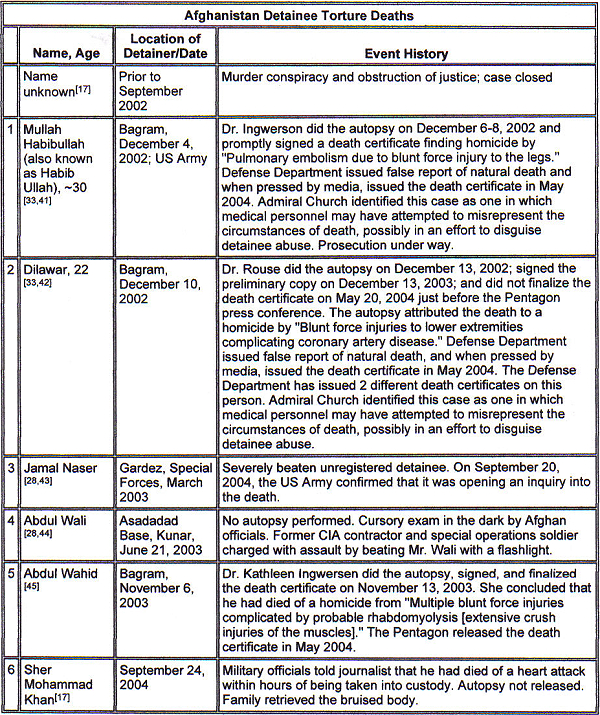
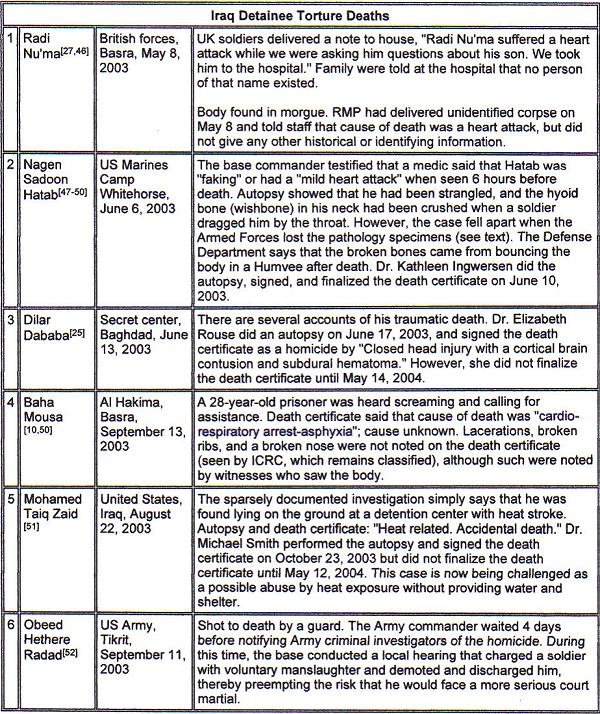
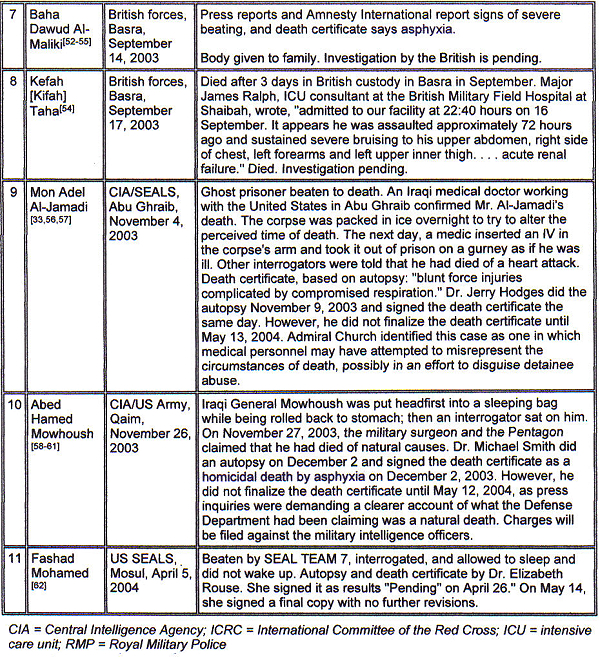
Substantiated and Unsubstantiated Homicides of Detainees
"Substantiated" criminal homicide by Armed Forces Criminal Investigation
"Unsubstantiated" due to unrecognized homicidal cause of death (false natural deaths)"
"Unsubstantiated" due to obstructed/incomplete investigation:
Medical Investigations of Prisoners' Deaths
The Armed Forces Institute of Pathology, Washington, DC, is responsible for determining the causes of deaths of prisoners who died in US detention facilities in Iraq, Afghanistan, and Guantanamo Bay. Ten years ago, the Institute created the Armed Forces Office of the Medical Examiner (AFME) to conduct autopsies of soldiers or civilians (including prisoners) who died while in the Armed Forces or under their jurisdiction. In 2002, budget cutbacks left the AFME with only 2 forensic pathologists; in 2004, it had 13. The AFME was not prepared to investigate the deaths of prisoners who may have died of torture. Its pathologists have published little on forensic pathology and are not known to have specialized expertise in investigating or documenting the injuries of persons who died under torture.[4,5]
Death Certificates
On May 21, 2004, a US Department of Defense press conference addressed concerns about the deaths of prisoners in Iraq and Afghanistan.[6] The Department released 23 death certificates that were incomplete and fell far short of standard medical practice or the requirements of the Geneva Convention (Figure 1). Thirteen of the death certificates do not note a date of birth, a vital statistic that would be helpful in evaluating the claim that many prisoners died of heart attacks. None record the next of kin or disposition of the remains. Many do not specify the location of death: Four simply record "Iraq." The incompleteness of the death certificates and autopsy reports suggests that Armed Forces pathologists supervising prisoners' autopsies did not have access to medical records, information about events preceding the deaths, or the circumstances under which the bodies were found to correlate with autopsy findings. Medical records were rarely created for Iraqi prisoners.[7,8] If available, field investigators inconsistently noted their contents. Field investigators rarely documented any inquiry into confinement or interrogation events preceding the death.

The death certificate sections entitled "Other Significant Conditions" and "Major Autopsy Findings" are blank. Given that half of the deaths were caused by physical abuse, it is notable that none of the persons dying of "natural causes" had any noteworthy signs of trauma. For example, Baha Mousa was arrested and died in August 2003. He was heard screaming. A person who saw the body saw lacerations, severe chest trauma, and a broken nose. The death certificate said that the cause of death was "cardio-respiratory arrest-asphyxia" of unknown cause and does not record any signs of trauma.[9,10]
The May 2004 death certificates appear to have been finalized for the press conference rather than completed during the routine work of the pathologists. Most bear preliminary signatures dated within a week of the death, but 17 of 22 certificates for deaths occurring between 2002 and 2004 were finalized within 9 days of the press conference. It appears that pathologists signed his or her batch of certificates at a single sitting at which the earlier and later signatures were affixed. Figure 2, for example, shows all 5 death certificates signed by Major Michael E. Smith. It appears that he used 1 pen and signature mark to simultaneously put a preliminary signature on certificates dated August 22, 23, and 25, 2003 and on October 23 and December 2, 2003, and then finalized those same certificates on May 12, 2004 with the same pen and hand stroke. A similar pattern is seen on death certificates signed by Colonel Eric Berg, Lieutenant Colonel Elizabeth Rouse, and Major Louis Finelli. James Caruso used the same signatures on his 3 death certificates and signed one for Jerry Hodge on May 13, 2004.
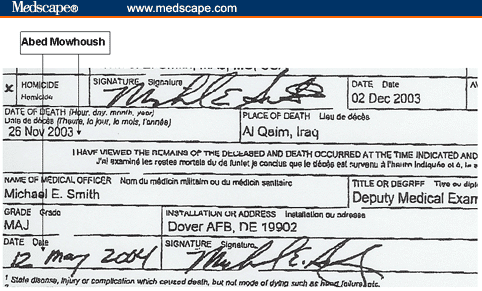 |
 |
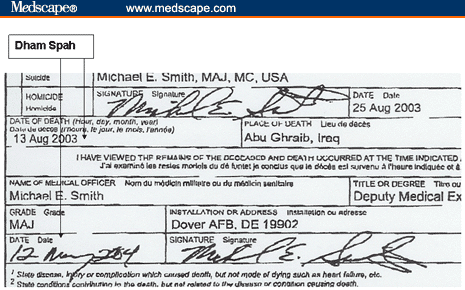 |
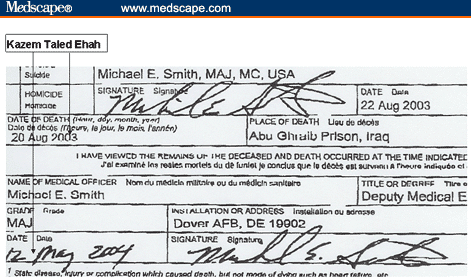 |
 |
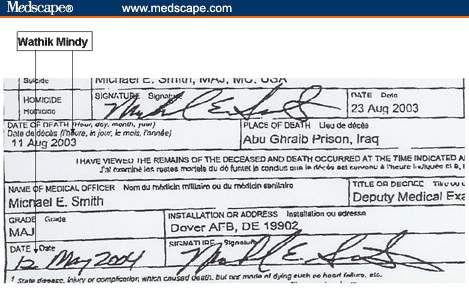 |
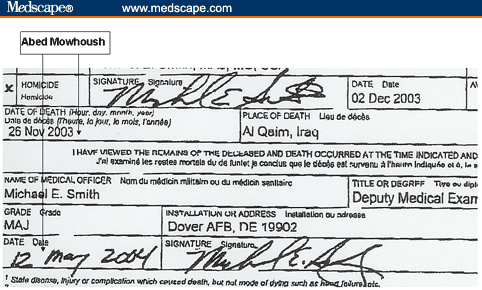
Figure 2: Major Michael E. Smith preliminary and final death certificate signatures.
Two prisoners inexplicably have 2 differing final death certificates. Dilawar was a prisoner who was murdered in Afghanistan. A retyped certificate adds his age, religion, and a comment on the circumstances of death. The date of death and the rank, title, and address of the name-censored pathologist and the final signature date are also all changed. Fahin Ali Gumaa, who died after being shot under unclear circumstances, has 2 death certificates -- one finalized before the May 2004 press conference and another finalized in June.
"Natural Deaths"
It is probably inevitable that some prisoners who reportedly died of "natural causes" in truth died of homicide. However, the nature of Armed Forces' medical investigations made this kind of error more likely. The AFME reported homicide as the cause of death in 10 of the 23 death certificates released in May 2004. The death of Mohamed Taiq Zaid was initially attributed to "heat"; it is currently and belatedly being investigated as a possible homicide due to abusive exposure to the hot Iraqi climate and deprivation of water.
Eight prisoners suffered "natural" deaths from heart attacks or atherosclerotic cardiovascular disease. Threats, beatings, fear, police interrogation, and arrests are known to cause "homicide by heart attack" or life-threatening heart failure. People with preexisting heart disease, dehydration, hyperthermia, or exhaustion are especially susceptible.[11-15] No forensic investigation of lethal "heart attacks" explores the possibility that these men died of stress-induced heart attacks. There are a number of reports of "heart attack" following harsh procedures in rounding up noncombatants in Iraq and Afghanistan. A typically sketchy US Army report says, "Detainee Death during weekend combat . . . . Army led raid this past weekend of a house in Iraq . . . an Iraqi who was detained and zip-locked (flexi-cuffed with plastic bands tying his wrists together) died while in custody. Preliminary information is that the detainee died from an apparent heart attack.[16]" Sher Mohammad Khan was picked up in Afghanistan in September 2004. Shortly thereafter, his bruised body was given to his family. Military officials told journalists that he had died of a heart attack within hours of being taken into custody. No investigation, autopsy, or death certificate is available.[17] An account collected by the Christian Peacemaker Team also suggests a stress-induced heart attack. On December 21, 2003, soldiers burst into the home of Mehadi Al Jamal, a retired land surveyor who lost an election because he was not a member of Saddam Hussein's Ba'ath Party. The 70-year-old man had a hip replacement and walked with a cane. The Christian Peacemaker Team reports the son as saying[18]:
They pushed him like a criminal; they didn't let him use his cane because his hands were tied. They handcuffed and put plastic hoods on my father, my uncle and my brother. I heard my father say, "I can't breathe. . ." They pushed him into the vehicle. My father was in very bad condition at that time. He couldn't talk because of the bag. . . . I could hear him gasping . . . After that, my father stopped moving . . . [An] officer told me my father died from a heart attack.
Abed Al Razak was treated at the Abu Ghraib hospital in mid-2004 for an unspecified cardiac condition several days before he suddenly died. Criminal investigators carefully documented the attempted resuscitation. They noted that the body had "no apparent signs of extraordinary trauma or injury," but they didn't record any inquiry into the nature of his interrogation or confinement. Thus, it is not known whether Mr. Razak was hooded with a sandbag that impaired his breathing or ability to exhale body heat. It is not known whether he was subject to prolonged stress positions, "fear up harsh," heat or cold exposure, sleep deprivation, shouted threats, continuous loud noise, sexual humiliation, or whether he saw a relative being beaten.[19]
Adbul Kareen Abdura Lafta (also known as Abu Malik Kenami) was admitted to Mosul prison on December 5, 2003 and died 4 days later.[20,21] The short, stocky, 44-year-old man weighed 175 pounds. He was never given a medical examination, and there is no medical record. After interrogation, a sandbag was put over his head. When he tried to remove it, guards made him jump up and down for 20 minutes with his wrists tied in front of him and then 20 minutes more with his wrists bound behind his back with a plastic binder. The bound and head-bagged man was put to bed. He was restless and "jibbering in Arabic." The guards told him to be quiet. The next morning, he was found dead. The body had "bloodshot" eyes, lacerations on his wrists from the plastic ties, unexplained bruises on his abdomen, and a fresh, bruised laceration on the back of his head. US Army investigators noted that the body did not have defensive bruises on his arms, an odd notation given that a man cannot raise bound arms in defense. No autopsy was performed. The death certificate lists the cause of death as unknown. It seems likely that Mr. Kenami died of positional asphyxia because of how he was restrained, hooded, and positioned. Positional asphyxia looks just like death by a natural heart attack except for those telltale conjunctival hemorrhages in his eyes.
[CHAS NOTE: The ABSENCE of "telltale conjunctival hemorrhages" (petechiae) in the eyes does NOT "rule OUT" positional asphyxia (or restraint asphyxia). Both positional asphyxia and restraint asphyxia victims may have NO postmortem petechiae. However, the presence of petechiae STRONGLY indicates positional asphyxia or restraint asphyxia.]
Mishandled Forensic Medical Evidence
The Office of Medical Examiners did not develop adequate procedures for preserving evidence for trial. The cooler containing the autopsy specimens of the murdered prisoner, Mr. Nagen Sadoon Hatab, exploded while sitting on a hot airport tarmac awaiting transport to trial. Pathologist Colonel Kathleen Ingwersen lost the broken neck hyoid (wishbone) bone showing that a soldier had strangled Mr. Hatab. The throat and rib cage were found on 2 different continents. As Dr. Ingwersen explained, "I should have paid closer attention . . . instead of relying on what turned out to be a miscommunication with my assistant." She suggested that she mishandled evidence because she was taking a drug to treat an allergic reaction to sandfly bites. The Armed Forces Institute of Pathology then obstructed the trial by refusing to allow independent DNA testing on the decedent's rib cage that they had temporarily lost so that the prosecution could prove that it came from the decedent. The judge rebuked the Institute for its lack of cooperation, and the broken chain of evidence except the homicide charges were dropped against several defendants.[22,23] The effect of the existence of 2 differing death certificates on the trial of those who murdered Dilawar remains to be seen.
Obstructed Death Investigations
Several Defense Department practices facilitate obstructing the medical evaluation of a death so that investigators are less likely to substantiate that a homicide occurred. Local commanders aborted or delayed some death investigations. At Husaybah, an unnamed prisoner made more than 20 escape attempts in 36 hours before he reportedly threw himself out of a window and died of head trauma. It is difficult to understand -- given the routine use of restraints on noncompliant prisoners -- how such a prisoner could throw himself out of a window. The camp commander delayed reporting the death. A cursory and inconclusive investigation was conducted more than a month after the body had been buried.[24] At Camp Cropper in 2003, an Iraq prison where many detainees were abused, 2 investigations were locally closed without autopsies.[25] In one, a prisoner being treated for chest pain "fell out of bed and struck his head. A CAT scan showed intra cranial trauma and signs of prior head injuries." Another detainee was found "unresponsive by guards"; the body did not exhibit any signs of abuse or foul play.
It is highly likely that investigators failed to substantiate homicides of ghost detainees.
CHAS NOTE: Dr. Miles failed to offer a definition of "ghost detainee" in his article.Mr. Hadi Abdul Hussain Hasson was a ghost detainee at Camp Bucca in Iraq. He was captured on an unknown date in the spring of 2003. US Army investigators learned of his death on July 27, 2004. The investigator wryly notes, "Due to inadequate record keeping, this office could only estimate that Mr. Hasson possibly died between April-Sept 03." Mr. Hasson's name was not found on the camp roster, military intelligence notes, medical records, or autopsy reports. The US Army death homicide investigation was "unsubstantiated," but the investigation file contains a note, "Preliminary investigation has revealed the following detainees have alleged they were abused while in Coalition custody . . . Hussain Hasson.[26]" Nasrat Mohammad "Amer" Abed al-Latif disappeared after being taken into custody. The 23-year-old Iraqi physics student was shot during a raid on his house by plain-clothed armed men who appeared to be US nationals. His father and 2 brothers were detained for 5 days. Soldiers told the family that they had taken the injured Amer to a medical facility where he had died and that his body would be returned to them. His body and records of his care have disappeared.[27] Jamal Naseer was picked up by US Special Forces in Afghanistan in March 2003. He was held in a small, overcrowded detention cell at Gardez, a facility that did not register its prisoners and which was closed to Red Cross monitors. No medical personnel visited Naseer during the 17 days that he was held and beaten. Men arrested with Mr. Naseer were beaten, kicked, whipped, slammed against the wall, and immersed in cold water. Their toenails either fell off or were torn off. Eyewitnesses report that Mr. Naseer suddenly fell to the ground, seized, and died. He was bleeding from his ear. The clinical history suggests that he died of a basilar skull fracture, an injury caused by severe head trauma with a hard object. His death was not mentioned in the Pentagon's updated list of 39 detainee deaths in July 2004. The Pentagon claims that it did not know of this case until a human rights organization, the Crimes of War Project, informed them of the matter. Six months after he died, the US Army announced that it was opening an inquiry.[28]
Granted, it's pretty obvious what it means. But, I wanted an "official" definition of it.
So, I searched the Internet. According to http://www.asil.org/insights/insigh134.htm:
"ghost detainees" are individuals "who have been taken into custody without notification
to their relatives, or without a record of their incarceration being made."
"Rendition" is the practice of transporting prisoners to countries that practice torture for interrogation and imprisonment. It is against US law and the Geneva Convention. There is no account of the fates of the several hundreds of persons who have been tortured during this practice.[29] The United States bears responsibility for homicides of these prisoners.
The US Department of Defense Responds
In 2004, in response to challenges to the veracity of death certificates and cases in which the reported cause of death had changed from "natural causes" to "homicide," Pentagon spokesperson Lieutenant Colonel Ellen Krenke asserted, "There is no evidence that final death certificates were falsified.[30]" Another official offered a similar view: "An initial reported cause of death is a field expedient process, often made by local medical personnel not fully qualified to certify cause of death. Autopsies corroborate or correct initial inaccuracies.[31]" In February 2005, Assistant Secretary of Defense for Health Affairs, Dr. William Winkenwerder, MD, reiterated that there is "no evidence" of falsification of detainee death reports.[32]
In 2005, the Defense Department released the Executive Summary of Vice Admiral Albert Church's investigation of interrogation operations. It claims to have reviewed 68 detainees' deaths, but neither lists these deaths nor states whether they included all the prisoners who died. Some of these deaths were by criminal and justified homicide; some were by natural causes. Without further comment, Admiral Church noted 3 cases (Mullah Habibullah, Dilawar, and Al-Jamadi) in which medical personnel may have attempted to misrepresent the circumstances of death, possibly in an effort to disguise detainee abuse.[33]
Discussion
The Armed Forces Institute of Pathology bears primary responsibility for the inadequate investigation of detainees' deaths. There is no evidence that its staff properly and forcefully asserted the need for field commanders to follow Defense Department policies for reporting prisoners' deaths for investigation. In June 2004, in the wake of public concern about unreported deaths of prisoners under torture, US Secretary of Defense Donald Rumsfeld sent a memo to field commanders reiterating US Department of Defense policies for reporting and investigating prisoner deaths.[34] The Institute's death certificates failed to comply with US Army and Geneva Convention obligations. In civilian practice, when a physician does not know the cause of death or where the death is under investigation, the proper procedure is to write "pending investigation" or similar phrasing on the death certificate rather than entering a misleading or exculpatory cause. US Army regulations dictate a similar standard: "When the cause of death is undetermined, the medical officer will make a statement to that effect. When the cause of death is finally determined, a supplemental report will be made.[35]"
Delayed death certificates have harmful consequences. They hamper investigators who use their findings to question witnesses while their memories are fresh. The contorted construction of "final death certificates" does not comport with Defense Department policy and allowed Defense Department spokespeople to knowingly announce that deaths were due to natural causes, an impression that Armed Forces' pathologists who knew better did not challenge. For example, Pentagon officials claimed that Iraqi General Abed Hamed Mowhoush died of natural causes. Reporters learned that he had been beaten, stuffed headfirst into a sleeping bag, and sat on until he died. A paramedic could not resuscitate him; a military surgeon declared death by natural causes. Six months after his death, the US Army released a death certificate and reported that he had died of homicide. A similar sequence of an incorrect Defense Department report of "natural deaths" followed by late-arriving death certificates finding that "homicide" occurred in the cases of Dilawar and Habibullah. Delayed death certificates make it difficult to create the Geneva-mandated registries of decedents so that families can be notified and bodies claimed for burial. For example, Mr. Al Jamadi died November 4, 2003; his death certificate was finalized on May 13, 2004 as his body lay unclaimed in the Baghdad Morgue.[36] For want of a death certificate, relatives can be unable to get death benefits, seek redress, or have the closure of learning how and when a loved one died.
The AFME failed to fulfill its own policy and its Geneva obligation to ensure that death investigations could be used for sentinel public health research to identify torture as a pattern of preventable death.[37] This failure was of critical importance between 2002, when human rights organizations began complaining of prisoner abuse, and 2004, when the Abu Ghraib photographs became public. By failing to report statistics on deaths by torture or signs of abusive injuries, it failed to perform its duty to issue an authoritative early warning that something was seriously wrong in the prisons.
The failures of the Armed Forces Institute of Pathology were amplified by other administrative, investigatory, and prosecutorial failures by the US Department of Defense and Central Intelligence Agency (CIA). The US Department of Defense has not provided a public accounting of the names, locations, circumstances, and numbers of prisoners who died by abuse or natural causes during arrest, transport to prisons, or imprisonment. It has failed to allow an independent review of autopsy photographs, particularly of the exterior of the bodies, which may show trauma that went unnoted. Allowing base commanders to abort or delay the investigations of prisoners' deaths made it less likely that investigators would be able to substantiate that a criminal homicide had occurred. The failure to create prisoners' internment records containing demographic, medical, and family information and the failure to investigate the interrogation procedures deprived pathologists of the information that they needed for assigning a cause of death. The unexamined deaths of ghost detainees and of those who were sent to other torturing nations for interrogation are not counted, and it is unlikely that those responsible will ever be held accountable.
Even when investigators found a criminal homicide, the US Department of Defense was reluctant to prosecute those involved or who were aware of the abuse. A soldier who shot a prisoner to death was not prosecuted because he was not informed about the rules for using force against prisoners.[38] At Camp Bucca in September 2003, an International Committee of the Red Cross monitor saw a guard shoot a prisoner in the chest. The monitor said, "The shooting showed a clear disregard for human life and security of the persons deprived of their liberty.[9]" The US Army concluded that the shooting was justifiable. Escaping, nonthreatening detainees were shot on other occasions.[39] The base commander at Tikrit prison used an administrative procedure to preempt the prosecution of the soldier who killed Obeed Hethere Radad (see Table). Most of the soldiers prosecuted for criminal homicides of prisoners received nonjudicial punishments, such as a reduction in rank, and the record of charges, punishments, and even the name of the victim are sealed.[3]
War conspires against forensic medicine. Autopsy facilities are inadequate and often far removed from prisons. There is often a low priority for employing military resources for forensic investigations. However, a great deal of material was available to the Armed Forces Institute of Pathology to assist its work. The UN and World Medical Association endorse the Manual on Investigation and Documentation of Torture and Other Cruel, Inhuman or Degrading Treatment or Punishment. It says that physicians evaluating corpses that may have been tortured must be trained to detect and document signs of torture. It specifies that corpses should be examined for signs of beatings, thermal and chemical burns, visible and invisible fractures, and signs of tight ligaments around the penis or extremities, suffocation, brain damage, suspension tears to ligaments or muscles or nerves, and anal or vaginal penetration. Each of these kinds of abuses has been reported in Armed Forces detention centers. That Manual, called the "Istanbul Protocol," further states, "Forensic doctors should not falsify their reports but should provide impartial evidence including making clear in their reports any evidence of maltreatment.[40,41]"
The failures of the Armed Forces Institute of Pathology have had diverse adverse consequences. A death monitoring system, which might have led to earlier awareness and prevention of homicides and abuse caused by torture, was never operational. Mishandled evidence and incomplete evaluations allowed alleged perpetrators of lethal torture to go unprosecuted. The failure to integrate the completion of death certificates into a Geneva-mandated system for notifying relatives of deaths compounded the grief, anger, and uncertainty of families. Bodies were administratively buried rather than being interred by relatives with proper ceremonies in the family's chosen place of interment. Our national reputation and interests were harmed by these failures.
Endnotes
Citations to government documents have been facilitated by the anthology: The Torture Papers: The Road to Abu Ghraib. Greenberg KJ, Dratel JL, eds. New York: Cambridge University Press; 2005. Its pagination will be used whenever possible.
Citations to government documents that are not in The Torture Papers pose unique bibliographic challenges. Subject fields, authors, recipients, and dates have often been redacted. The documents are neither catalogued nor indexed. Many, but not all, have page stamps with several different prefixes (no prefix, DODDOACID or DOD). Accordingly, the letterhead name of the agency, date, and pagination are the best available citations at this time. Media and Defense Department documents have been posted and taken down; therefore, documents are not cited by the original URLs from which they were downloaded. The ACLU and Center for Public Integrity maintain repositories of government documents at http://www.aclu.org/tortureFOIA and http://www.publicintegrity.org/report.aspx?aid=396&sid=100. For brevity, all dates are given as month/day/year.

References for:
Medical Investigations of Homicides of Prisoners of War in Iraq and Afghanistan


 Email Charly at: c-d-miller@neb.rr.com
Email Charly at: c-d-miller@neb.rr.com